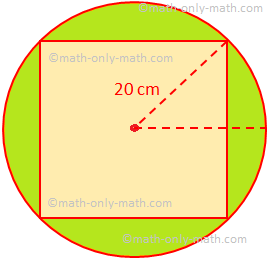Subscribe to our ▶️ YouTube channel 🔴 for the latest videos, updates, and tips.
Area and Perimeter of Combined Figures
Here we will solve different types of problems on finding the area and perimeter of combined figures.
1. Find the area of the shaded region in which PQR is an equilateral triangle of side 7√3 cm. O is the centre of the circle.
(Use π = \(\frac{22}{7}\) and √3 = 1.732.)
Solution:
The centre O of the circle is the circumcentre of the equilateral triangle PQR.
So, O is also the centroid of the equilateral triangle and QS ⊥ PR, OQ = 2OS. If the radius of the circle be r cm then
OQ = r cm,
OS = \(\frac{r}{2}\) cm,
RS = \(\frac{1}{2}\) PR = \(\frac{7√3}{2}\) cm
Therefore, QS\(^{2}\) = QR\(^{2}\) - RS\(^{2}\)
or, (\(\frac{3r}{2}\))\(^{2}\) = (7√3)\(^{2}\) - (\(\frac{7√3}{2}\))\(^{2}\)
or, \(\frac{9}{4}\) r\(^{2}\) = (1 - \(\frac{1}{4}\)) (7√3)\(^{2}\)
or, \(\frac{9}{4}\) r\(^{2}\) = \(\frac{3}{4}\) × 49 × 3
or, r\(^{2}\) = \(\frac{3}{4}\) × 49 × 3 × \(\frac{4}{9}\)
or, r\(^{2}\) = 49
Therefore, r = 7
Therefore, area of the shaded region = Area of the circle – Area of the equilateral triangle
= πr\(^{2}\) - \(\frac{√3}{4}\) a\(^{2}\)
= \(\frac{22}{7}\) × 7\(^{2}\) cm\(^{2}\) - \(\frac{√3}{4}\) × (7√3)\(^{2}\) cm\(^{2}\)
= (154 - \(\frac{√3}{4}\) × 147) cm\(^{2}\)
= (154 - \(\frac{1.732 × 147}{4}\)) cm\(^{2}\)
= (154 - \(\frac{254.604}{4}\)) cm\(^{2}\)
= (154 - 63.651) cm\(^{2}\)
= 90349 cm\(^{2}\)
2. The radius of the wheels of a car is 35 cm. The car takes 1 hour to cover 66 km. Find the number of revolutions that a wheel of the car makes in one minute. (Use π = \(\frac{22}{7}\).)
Solution:
According to the problem, radius of a wheel = 35 cm.
The perimeter of a wheel = 2πr
= 2 × \(\frac{22}{7}\) × 35 cm
= 220 cm
Therefore, the number of revolutions of a wheel to cover 66 km = \(\frac{66 km}{220 km}\)
= \(\frac{66 × 1000 × 100 cm}{220 cm}\)
= \(\frac{3 × 1000 × 100}{10}\)
= 30000
Therefore, the number of revolutions of a wheel to make in
one minute = \(\frac{30000}{60}\)
= 500
3. A circular piece of paper of radius 20 cm is trimmed into the shape of the biggest possible square. Find the area of the paper cut off. (Use π = \(\frac{22}{7}\).)
Solution:
The area of the piece of paper = πr\(^{2}\)
= \(\frac{22}{7}\) × 20\(^{2}\) cm\(^{2}\)
If the side of the inscribed square be x cm then
20\(^{2}\) = (\(\frac{x}{2}\))\(^{2}\) + (\(\frac{x}{2}\))\(^{2}\)
or, 400 = \(\frac{1}{2}\) x\(^{2}\)
or, x\(^{2}\) = 800.
Therefore, the area of the paper cut off = The area of the circle - The area of the square
= πr\(^{2}\) - x\(^{2}\)
= \(\frac{22}{7}\) × 20\(^{2}\) cm\(^{2}\) - 800 cm\(^{2}\)
= (\(\frac{8800}{7}\) - 800) cm\(^{2}\)
= \(\frac{3200}{7}\) cm\(^{2}\)
= 457\(\frac{1}{7}\) cm\(^{2}\)
From Area and Perimeter of Combined Figures to HOME PAGE
Didn't find what you were looking for? Or want to know more information about Math Only Math. Use this Google Search to find what you need.





New! Comments
Have your say about what you just read! Leave me a comment in the box below. Ask a Question or Answer a Question.